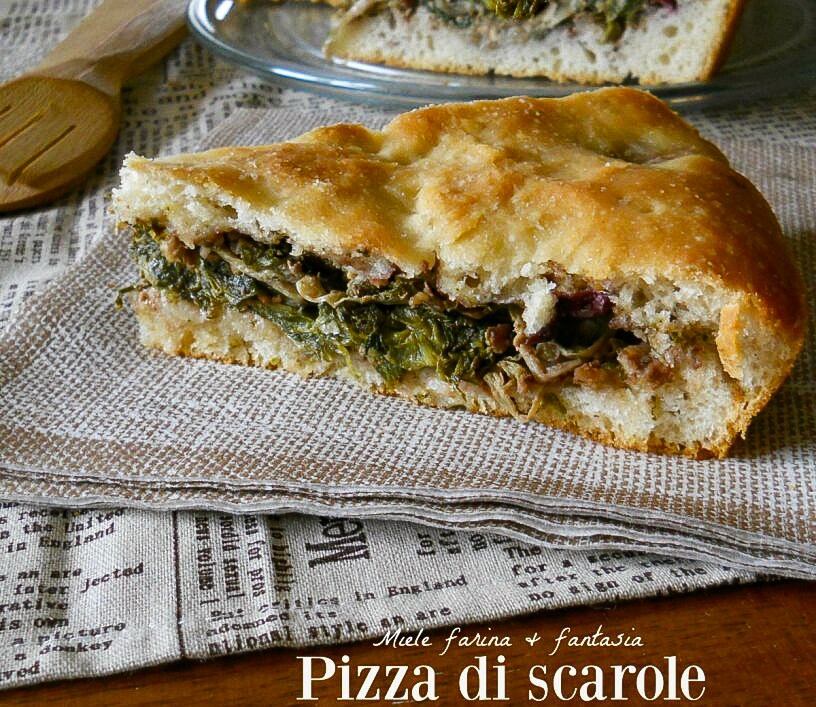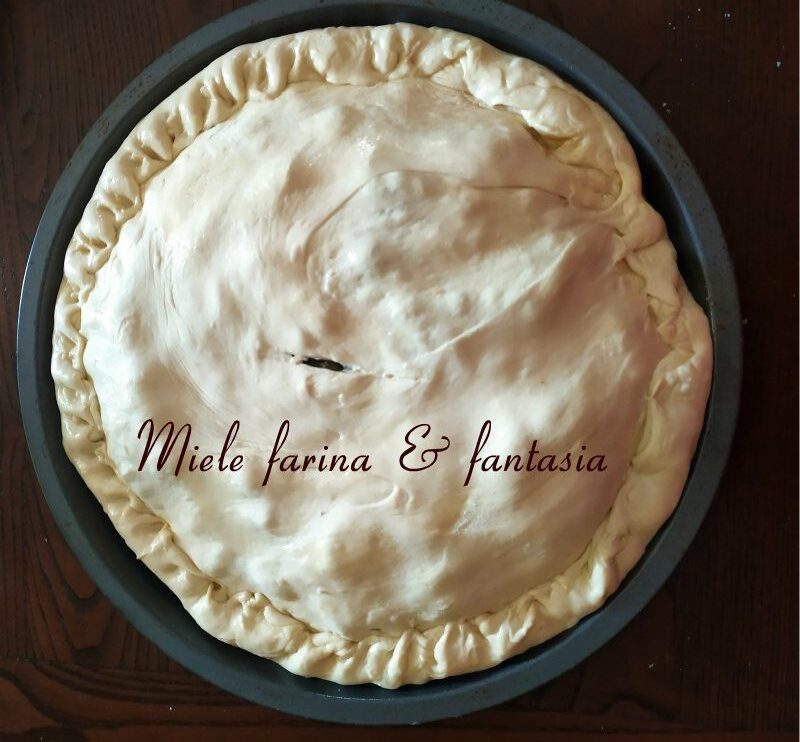Today we talk about Neapolitan escarole pizza, a rustic recipe typical of Campania; a leavened bread that, by tradition, is eaten both hot and cold on Christmas Eve and New Year’s Eve (although I personally make it several times a year and also on Holy Saturday). For me, escarole pizza means the festive season and I remember my mother preparing it, stretching the dough thin because she liked it to be thin and “crispy”. Neapolitan escarole pizza is a rich, succulent, and flavorful dish, despite the simplicity of its ingredients which, however, characterize its goodness. The pizza dough is made with brewer’s yeast (it can also be made with natural yeast, of course); the filling consists, in the basic version, so to speak, of escarole, Gaeta black olives, salted anchovies, raisins, and capers. In some areas of Campania, escarole pizza is also enriched with other ingredients, such as dried and dehydrated fruit, like walnuts and pine nuts, dried figs, giving it a pleasant sweet and salty note at the same time. This is the basic version of my family, but I like the Neapolitan escarole pizza to be “soft” and taller. For a completely vegetarian version, just avoid adding anchovies among the ingredients and increase the amount of olives and capers.
This time I didn’t take a full picture of the entire pizza, but only a part, because I hope the slice in the foreground is enough to show how good, soft, with light and rich crumb, the Neapolitan escarole pizza is.

- Difficulty: Easy
- Cost: Medium
- Rest time: 6 Hours
- Preparation time: 30 Minutes
- Portions: 8
- Cooking methods: Stove, Oven
- Cuisine: Italian
- Seasonality: Christmas
Ingredients
- 4 cups all-purpose flour
- 1 tsp fresh brewer's yeast
- 2 tsp fine salt
- 1 1/4 cups water
- 3 escarole (endive)
- 1 clove garlic
- 1 jar 80 grams anchovies in oil
- to taste Gaeta black olives
- to taste salted capers
- 1 tbsp raisins
- to taste extra virgin olive oil
Tools
- 1 Baking tray round shape 12-inch
Preparation
Rinse a heaping tablespoon of raisins thoroughly under running water; transfer them to a small saucepan with some water and bring to a boil (a couple of minutes), to revive them. Then, drain and let them cool.
Prepare the filling. After removing the wilted leaves, rinse the escarole thoroughly to remove any dirt residue.
Without draining them completely, transfer them to a large pot with a lid. Boil them on low heat for about fifteen minutes, stirring often in the pot. This operation serves to remove some of the bitterness that characterizes this vegetable, then drain them well.
Sauté a garlic clove in a large non-stick pan. Dissolve half the anchovy fillets in the hot oil and then add the pitted black olives, capers, and already revived raisins. Let them sauté for a minute on high heat, stirring often, then add the well-drained escarole and let them cook on low heat until the escarole is cooked and soft.
Adjust the salt only at the last minute because the capers are already very salty. Once cooked, let them cool and drain very well. It’s important that the escarole pizza filling is well-drained before being placed inside the dough, to prevent the cooking liquid from leaking out during rising, compromising it. However, do not discard the escarole sauce; you can use it to season pasta, as it is a very savory and tasty condiment.
Prepare the dough. In a large bowl, dissolve the brewer’s yeast in half of the water specified in the recipe. Add half the flour (already sifted) and mix roughly. At this point, you can add the remaining flour, salt, and water, a little at a time, until you reach a soft, pleasant-to-work-with, and somewhat sticky consistency (not all flours absorb liquids the same way, which is why I recommend pouring the water a little at a time, as you might need a bit less or a bit more than the doses I indicated to avoid ending up with unmanageable doughs). Work the dough until it becomes smooth and even (about ten minutes by hand; a bit less if using a mixer).
Divide the dough into two parts, one slightly larger than the other, and let them rise in separate containers, tightly sealed and lightly greased with a little oil. Rising times are purely indicative because they depend mainly on the ambient temperature in which they will rise. In my case, the dough took just over 3 and a half hours to double.
When the doughs are well-puffed, grease the baking tray with extra virgin olive oil and gently pour in the larger part. Spread it gently with your fingers to cover the entire tray.
Evenly distribute the escarole filling, add the remaining anchovy fillets (broken with your hands), and close with the other dough piece that you have stretched aside on a lightly floured surface.
Roll the outer edges of the two doughs together, forming a kind of cord. Make a small incision on the surface, in the center of the dough; in this way, the excess moisture will escape during cooking.
Finally, brush the entire surface of the escarole pizza with some extra virgin olive oil and let it rise again. In my opinion, the double rising is necessary to obtain a final product that is more digestible and remains soft even over the days.
When the pizza has risen (about a couple of hours), turn on the oven and set it to 390°F. Bake it (in the hot oven) at mid-height for about 25 minutes (I have a gas oven, and cooking times vary from oven to oven).
Once cooking is done, turn on the grill for a few minutes to brown the surface of the escarole pizza. Let it cool slightly before slicing and serving.


